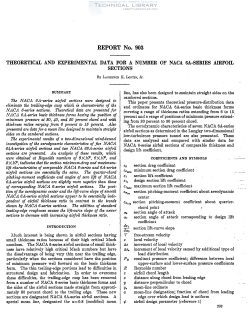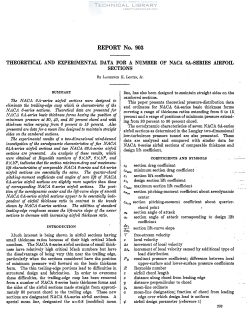naca-report-903

- Version
- 308 Downloads
- 1.94 MB File Size
- 1 File Count
- August 31, 2016 Create Date
- August 31, 2016 Last Updated
National Advisory Committee for Aeronautics, Report - Theoretical and Experimental Data for a Number of NACA 6A-Series Airfoil

The NACA 6A—series airfoil sect-ions were designed to
eliminate the trailing—edge c-usp which is characteristic of the
NACA 6-series sections. Theoretical data are presented for
NACA 6A—series basic thickness forms having the position of
minimum pressure at 30, 40, and 50 percent chord and with
thickness ratios varying from 6' percent to 15 percent. Also
presented are data for a mean line design-ed to maintain straight
sides on the cambered sections.
The experimental results of a two-dimensional wind-tunnel
investigation of the aerodynamic characteristics of fire NACA
64A—series airfoil sections and two NAOA 6'3A—series airfoil
sections are presented. An analysis of these results, which
were obtained at Reynolds numbers of 3X10“, 6X10“, and
3X10“, indicates that the section minimum-drag and maximum-
lift characteristics of comparable NAC’A 6-series and 6A-series
airfoil sections are essentially the same. The quarter-chord
pitching-moment coeflicients and angles of zero lift of NAC’A
6A—series airfoil sections are slightly more negatire than those
of corresponding NAC'A 6—series airfoil sections. The posi-
tion of the aerodynamic center and the lift-curve slope of smooth
NACA fiA-series airfoil sections appear to be essentially inde—
pendent of airfoil thickness ratio in contrast to the trends
shown by NAOA 6—series sections. The addition of standard
leading-edge roughness causes the lift-curve slope of the newer
sections to decrease with increasing airfoil thickness ratio.
Much interest is being shown in airfoil sections having
small thickness ratios because of their high critical Mach
numbels. The NACA 6-series airfoil sections of small thick-
ness have relatively high critical Mach numbers but. have
the disadvantage of being very thin near the trailing edge,
particularly when the sections considered have the position
of minimum pressure well forward on the basic thickness
form. The thin trailing-edge portions lead to difficulties in
structural design and fabrication. In order to overcome
these difficulties, the trailing-edge cusp has been removed
from a number of NACA 6-series basic thickness forms and
the sides of the airfoil sections made straight from approxi-
mately 80 percent chord to the trailing edge. These new
sections are designated NACA (SA-series airfoil sections.
| File | Action |
|---|---|
| naca-report-903 Theoretical and Experimental Data for a Number of NACA 6A-Series Airfoil.pdf | Download |
Comment On This Post